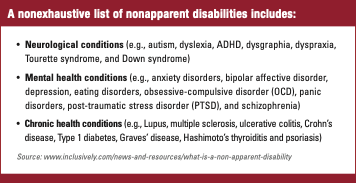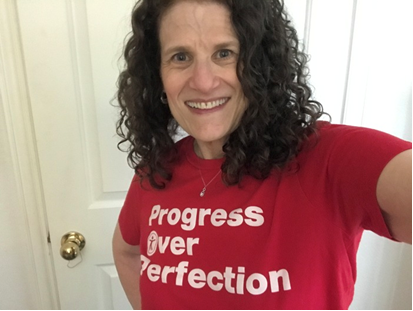
by Zoë Billington, User Research & Customer Insights, New York, New York, zbillington@gmail.com
This quarter, I (virtually) sat down with Meryl Evans, a professional speaker and trainer on accessibility and inclusion with a focus on people with disabilities and accessible communication. Clients hire Evans to speak to their employees on accessibility, inclusion, and lived experiences as a person with disabilities, and recently gave a TEDx Talk on how the pandemic impacted accessibility. On a personal note, she is a native Texan and two-time cookie competition winner!
Zoë Billington: It’d be great to start off with a little bit of background. What professional and personal experiences have shaped your career and led you to where you are today?
Meryl Evans: I’ve always cared about access for everyone and had learned about digital accessibility over the years, but the game changer for my career came in 2019. Before that could happen, we need to go back a year or two before that, when I started creating videos and content about creating quality captions. More and more videos started showing up on social media with no captions or poor-quality captions. This inspired me to start creating videos and content on why quality captions matter and how to create accessible captions.
Then I was invited to speak at Knowbility’s John Slatin AccessU, which was my first accessibility conference. I felt like I had found my community. After that experience, I knew I wanted to get into the accessibility profession, but I wasn’t sure how. I kept it in the back of my mind and meanwhile returned to my digital marketing freelance practice. My work caught the attention of a founder of an accessibility consultancy, and he brought me on as a digital marketer. This was another opportunity that shifted my career from digital marketing to more specialized accessibility marketing.
Then I took multiple courses, studied, and became a Certified Professional in Accessibility Core Competencies (CPACC), certified by the International Association of Accessibility Professionals (IAAP). Up until then I had a bit of imposter syndrome, thinking that people gave me work and speaking opportunities just because I was deaf. I wanted to show that I knew and cared about more than just hearing-related disabilities.
Zoë: Thanks for that fabulous overview. For readers who are less familiar with some of the ideas and terms you frequently talk about, can you share more on what it means to have a disability that isn’t visible, and why it is important for everyone to be aware of this?
Meryl: If you and I communicate only online, you will not know I have a disability. Aside from audio, my disability is invisible online. There are far more invisible disabilities than visible ones. Not all blind people wear sunglasses, use a cane, or have a service dog. Not all deaf people sign. Not all deaf people read lips.
Harvard Business Review says that 30 percent of the U.S. workforce fits the federal definition of having a disability, yet 61 percent of employees with disabilities have not disclosed their disabilities to their managers.1 When people don’t disclose, they are likely not getting all the tools they need to thrive and be successful in their roles. But, when we know about our differences and accept them, we can do things to help each other thrive. In video calls, people tell me to let them know if I miss something so they can rephrase or put it in the chat.
Zoë: When it comes to digital and nondigital accessibility, can you give some examples and what that looks like?
Meryl: Digital accessibility refers to anything related to digital, including apps, websites, and extended reality (i.e., virtual and augmented reality). Nondigital refers to real-world experiences such as customer service on the phone or in person, using a drive-through, or being in a building.
I’ve been working on something I call the 360-degree accessibility model because too often experiences will have an inaccessible component. Companies need to think of accessibility as a 360-degree experience that includes every digital and nondigital touchpoint. A great example is before we had at-home COVID-19 tests, we had to go in person to get them. I had no problem making an appointment at home online because I’m sighted. But I had a problem at the drive-through: I couldn’t communicate with the tester. This is not accessible. I learned that someone else with a mobility disability wanted drive-through testing, but when she got there, they told her she had to come inside. This is not accessible.
Zoë: That’s a great example that really illustrates the 360-degree nature of any experience. What advice would you give to a person or company who is “new” to thinking about 360-degree accessibility and wants to get started?
Meryl: First, it’s important to keep in mind that there is no such thing as perfection in accessibility. What you do to make something accessible for one person often makes it inaccessible for someone else. To go back to the COVID-19 example, creating an online registration page might be more accessible for someone who is deaf, but if not done correctly, it would be less accessible for someone who is blind than speaking over the phone. What may be accessible for some could be inaccessible for others. There’s no perfection in accessibility, which is why I say progress over perfection.
Zoë: Do you have any suggestions for how we can start creating progress, rather than getting caught up in perfection?
Meryl: There are two sides of the progress over perfection coin. One side is for those who are new to accessibility. It’s overwhelming to the point that they can’t get started, like facing a messy room and not knowing where to begin. But it’s not about doing it all. It’s about picking one thing in the room to clean up. For example, start with a small thing like adding captions to videos and providing descriptions of images. Don’t worry about getting the captions perfect or describing the images just right, because there’s no one way to describe an image. Just focus on getting started.
The other side of the coin is for the people already in the community. When they see something that is not accessible, they can be a little overzealous in their feedback and jump to criticism very quickly. This type of criticism can discourage people from trying. That’s why I practice progress over perfection—it is kinder, people respond better, and then they’re more likely to keep trying.
Zoë: How do you help companies progress toward creating an inclusive organization?
Meryl: Accessibility is everyone’s responsibility. The companies that are seeing the most progress in creating an inclusive environment are those that have held accessibility training for all employees. Having training shows executive-level, top-down commitment and helps employees understand the whys and the basics of the hows. I’ve developed and delivered that kind of training.
The other thing that’s important about companies that are succeeding with accessibility is everyone is accountable for accessibility. For example, someone in marketing needs to make public-facing content accessible, and someone in sales needs to make sure the presentations are accessible. Now, I don’t expect everyone to know how to do everything—not everyone needs to know how to make a PDF accessible—but there should always be someone in the company who knows how to do it.
Zoë: Keeping in mind that many of our readers are consultants, and therefore may not be working with the support of a larger company, do you have any suggestions for them when working with their clients?
Meryl: Consultants working with clients can ask questions about accessibility in their client’s products, services, and workplaces.
A simple place to start is to ask the people they collaborate with how they prefer to communicate. Make it a habit to always have the captions on without anyone asking. Make it a habit to offer people options in how they want to collaborate and communicate. Make it a habit to ask people how you can ensure they have everything they need to make the project successful.
To get started with those captions, just be aware that not all platforms do a good job, so test them out beforehand. The best thing to do in finding the right automatic captioning service or tool is to create a short video. Test that video with different tools and services until you find one that works for you. The list of options is long, as you can see in this FAQ post at https://bit.ly/3CBMr26.
Zoë: What advice do you give your clients when they hire you as an accessibility consultant for their company?
Meryl: New technologies can often leave people with disabilities behind. I emphasize that accessibility should be baked into new products and experiences—it should not be an afterthought. To illustrate this, I like to talk about the time my son and his friend made cupcakes but left out one teaspoon of salt. They couldn’t just sprinkle that on at the end—it needed to be baked in. The only way to do it right at that point was to start all over.
The same goes for accessibility for tech: bake it in from the beginning, and it’ll cost far less. If you have to redo it, it’s going to cost a lot more and take more time.
Zoë: One of your focuses is on how the deaf community can teach the hearing world to communicate better. What are some of your frustrations with doing business in the hearing world?
Meryl: The first is seeing video captions that are automated captions with no editing. Would you post an article on your website without editing? Of course not! So, why would you post a captioned video without editing the captions? Publishing a video with automatic captions without editing them is like publishing an article without editing it.
The second is everyone defaults to one method of communication: talking through a phone call. It’s fine to make contact a required field, but at least give people a choice of how they want to be contacted—whether it’s a call, text message, or email. When in person, be willing to communicate in other ways besides talking. You have one of the best communication tools with you at all times—your smartphone. You can use that to communicate in many ways.
For example, when I go to order a coffee, I speak my order, but what would I do if I couldn’t speak? I would write down my order on my phone—like I did at the airport when it was noisy and I couldn’t order though the app. Luckily the barista didn’t have any follow-up questions, but if she did, I bet you she would ask instead of writing it down. The more accessible thing to do is just keep a pen and paper handy or a phone you can type on.
Zoë: What do you believe are the most important things the hearing community can learn from the deaf community, and why?
Meryl: The biggest one is that there are different ways to communicate besides voice: Pen and paper. Gestures. Using the finger alphabet. Texting each other instead of talking. We need to normalize multiple ways of communicating.
Texting in person should not be awkward. You can text in your own way—you can either type your message into your phone using the keypad or use speech-to-text (for example, dictate your message for Siri to write out).
Zoë: That makes me think about when I lived in China, and I didn’t speak Chinese. I would frequently have conversations with people through a translator app on my phone. It didn’t feel awkward because we were finding a way to speak in each other’s language.
Meryl: Exactly. That’s what I talked about in my TEDx Talk—there are multiple ways of communicating when you’re communicating with someone who’s deaf or doesn’t speak your language.
Zoë: Let’s go full circle and end where your journey began: talking about captions, or as you’ve called them, “autocraptions.” Given that you are a professional speaker and QRCA puts on an annual conference, let’s focus on captions in the context of speaking engagements. What suggestions would you offer someone preparing a conference presentation to make it more accessible?
Meryl: I spoke at an in-person conference earlier this year, and they had automatic captions for all sessions through the conference app on your smartphone or laptop. A few people complained that the captions should’ve been on screen, on stage—but this goes back to progress over perfection. Not many conferences have even tried to provide captions, and this one did.
Also ensure that there are at least two ways for everyone to communicate virtually. I’ve been in webinars where they shut off the chat box because they don’t want to distract people or have participants chatting during the presentation. But then I feel cut off because I only have audio, and I always like to have another way to communicate if people don’t understand me.
For a presentation, have slides for deaf attendees, but not text-heavy slides, and always describe what’s on the slide for anyone who cannot see its content. Any images on a slide should be described and captioned. Caption all videos shown in the presentation.
Be cautious about animated GIFs because they are a problem for a lot of people. Speakers should give a warning if one is coming up—show it once or twice and then move to the next slide. But you don’t want the animation to go the whole time because it can be distracting or hurtful to people who are affected by movement, like those with epilepsy.
I’ll stop there because I don’t want to overwhelm anyone, but these are some great places to start.
Zoë: I think this is a great place to end: with some clear suggestions for all our readers to take away and use in their communications and presentations both in person and virtual. Thank you so much, Meryl!
References:
- Jain-Link, Pooja and Julia Taylor Kennedy, “Why People Hide Their Disabilities at Work,” Harvard Business Review, 2019: https://hbr.org/2019/06/why-people-hide-their-disabilities-at-work
- TedTalk Source: https://youtu.be/Wx8gGP79QTY


